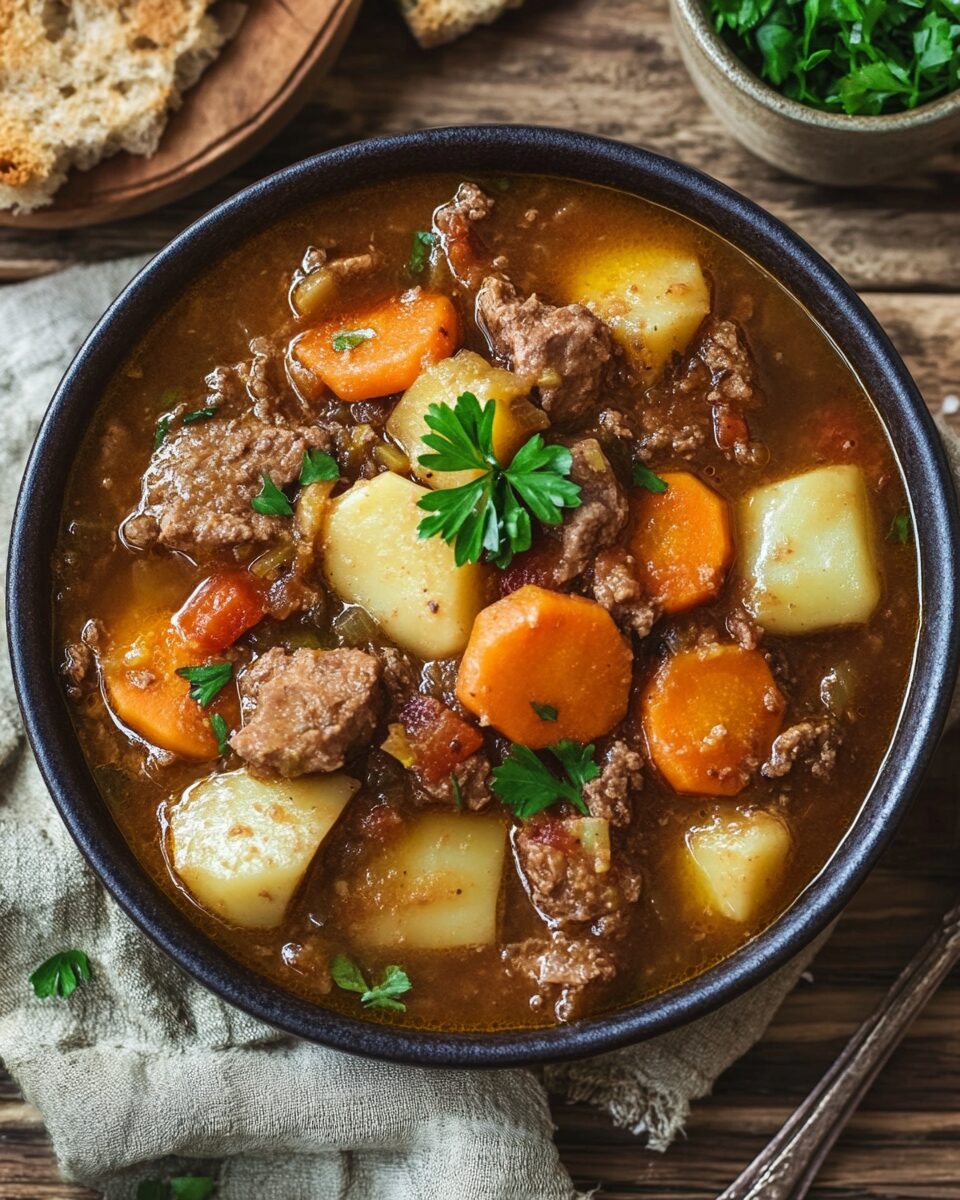Irish Stew is the epitome of comfort food, blending tender lamb, soft potatoes, and aromatic herbs into a rich, flavorful broth. Slow cooked to perfection, this dish has been a staple in Irish homes for generations, bringing warmth and nourishment to family tables. The simplicity of ingredients showcases the heart of Irish cuisine quality produce, straightforward techniques, and deep, satisfying flavors.
Whether you’re celebrating St. Patrick’s Day, craving a hearty winter meal, or simply looking to explore authentic Irish cooking, this Traditional Irish Stew is a must try. Serve it with crusty bread to soak up the delicious broth, and don’t forget a sprinkle of fresh parsley for a final touch of brightness.
Full Recipe:
Ingredients:
- 2 lbs lamb or mutton, cut into chunks
- 4 large potatoes, peeled and chopped
- 2 carrots, sliced
- 1 large onion, chopped
- 4 cups beef or lamb broth
- 1 tablespoon vegetable oil
- 2 cloves garlic, minced
- 2 sprigs fresh thyme
- 1 bay leaf
- Salt and black pepper, to taste
- ½ cup chopped fresh parsley (for garnish)
Directions:
- Heat the vegetable oil in a large pot over medium heat.
- Add the lamb pieces and brown them on all sides. Remove and set aside.
- In the same pot, sauté the onion and garlic until softened.
- Return the browned lamb to the pot, then add the broth, thyme, bay leaf, salt, and pepper.
- Bring to a boil, then reduce the heat and let simmer for 1 hour.
- Add the potatoes and carrots, then continue simmering for another 30 minutes or until vegetables are tender.
- Remove the bay leaf, adjust seasoning, and sprinkle with fresh parsley before serving.
Prep Time: 15 minutes | Cooking Time: 1 hour 30 minutes | Total Time: 1 hour 45 minutes
Kcal: 420 kcal per serving | Servings: 4
Traditional Irish Stew: A Timeless Comfort Dish
Irish cuisine is deeply rooted in history, tradition, and the land’s abundant natural resources. Among the most cherished dishes of Ireland is Traditional Irish Stew, a rustic and hearty meal that has been enjoyed for centuries. This dish embodies simplicity and sustenance, bringing together tender cuts of lamb, hearty potatoes, and flavorful root vegetables, all simmered slowly to create a rich and satisfying broth.
Whether enjoyed during the cold winter months or served as a staple dish on St. Patrick’s Day, Irish Stew is a true reflection of Irish culinary heritage. It’s not just a meal it’s a story of survival, adaptation, and the deep connection between the Irish people and their land.
The History of Irish Stew
Irish Stew has a long and humble history that dates back to the early days of Ireland’s rural farming communities. The dish was developed out of necessity, using what was available to farmers and their families. Traditionally, mutton (the meat of older sheep) was the preferred protein, as it was more affordable and accessible than other meats. The tougher cuts of meat required slow cooking to break down the fibers, making stew the perfect preparation method.
In addition to mutton, potatoes became a staple ingredient in Irish Stew after they were introduced to Ireland in the 16th century. Potatoes were inexpensive, filling, and grew well in the Irish climate, making them a fundamental part of the diet. Alongside potatoes, onions, carrots, and other root vegetables were added for flavor and nutrition.
Over time, the recipe evolved, and some modern variations now include lamb instead of mutton, as well as additional ingredients such as parsnips, turnips, and even Guinness beer for a deeper, maltier flavor. Despite these variations, the essence of Irish Stew remains unchanged it is a dish meant to provide warmth, nourishment, and comfort.
Why Irish Stew is a Beloved Dish
1. Simple Yet Flavorful
One of the greatest appeals of Irish Stew is its simplicity. The dish is made with only a handful of ingredients, yet the result is incredibly rich in flavor. The slow cooking process allows the meat to become fork tender, while the potatoes and vegetables absorb the broth, creating a wonderfully hearty meal.
2. A Symbol of Irish Culture
Food is an essential part of cultural identity, and Irish Stew is one of the most iconic dishes in Irish cuisine. It represents the resilience of the Irish people, who have faced hardships throughout history but always found ways to create delicious, comforting meals from basic ingredients. The dish is particularly popular during Irish festivals, especially on St. Patrick’s Day, when people around the world celebrate Irish heritage through food, music, and traditions.
3. Hearty and Nutritious
Irish Stew is a wholesome dish packed with proteins, fiber, and essential vitamins. The lamb provides a great source of iron and protein, while the vegetables contribute to a balanced and nourishing meal. The broth, rich in natural collagen from the slow cooked meat, is not only flavorful but also beneficial for overall health.
4. Versatile and Adaptable
While traditional Irish Stew consists of lamb or mutton, potatoes, and onions, many variations exist today. Some cooks add Guinness beer for a bolder taste, while others incorporate fresh herbs like rosemary and thyme to enhance the aroma. It can be served with crusty bread to soak up the delicious broth or paired with a side of Irish soda bread for a truly authentic experience.
Tips for Making the Perfect Irish Stew
Creating a delicious Irish Stew is easy, but a few tips can elevate the dish to the next level:
- Choose the Right Meat: Traditionally, mutton was used, but lamb is now the preferred option due to its tenderness. Bone-in lamb shoulder or lamb neck adds extra richness to the broth.
- Slow Cook for Maximum Flavor: The key to a perfect stew is slow cooking. Letting it simmer for at least 1.5 to 2 hours allows the flavors to develop fully.
- Use Starchy Potatoes: Russet potatoes or Yukon Golds work best because they break down slightly, thickening the broth naturally.
- Don’t Rush the Browning Step: Browning the meat before simmering enhances the depth of flavor and creates a more robust stew.
- Let It Rest Before Serving: Like many stews, Irish Stew tastes even better the next day as the flavors continue to meld. If possible, prepare it a day in advance for the best results.
Pairing Irish Stew with the Right Sides
While Irish Stew is a standalone meal, pairing it with complementary sides enhances the experience. Some great options include:
- Irish Soda Bread: A dense, slightly tangy bread that pairs beautifully with the stew’s rich broth.
- Colcannon: A creamy mashed potato dish mixed with kale or cabbage, adding another layer of Irish tradition to your meal.
- Guinness Beer: If you’re looking for a drink pairing, a pint of Guinness or another dark Irish stout complements the flavors of the stew perfectly.
- Boxty (Irish Potato Pancakes): A crispy, pan fried alternative to traditional mashed potatoes that provides a delightful texture contrast.
Conclusion: The Timeless Appeal of Irish Stew
Traditional Irish Stew is more than just a meal it’s a piece of Irish history, a symbol of resilience, and a comforting dish that has stood the test of time. From its humble beginnings in rural Ireland to its place on modern dinner tables around the world, this dish continues to bring people together with its warm, nourishing flavors.
Whether you’re celebrating St. Patrick’s Day, cooking a hearty winter meal, or simply wanting to experience authentic Irish cuisine, Irish Stew is a must-try. With its simple ingredients, rich flavors, and cultural significance, it’s no wonder this dish has remained a favorite for generations.
So, the next time you’re looking for a cozy, filling meal, give Irish Stew a try you might just find a new favorite dish to add to your rotation!






